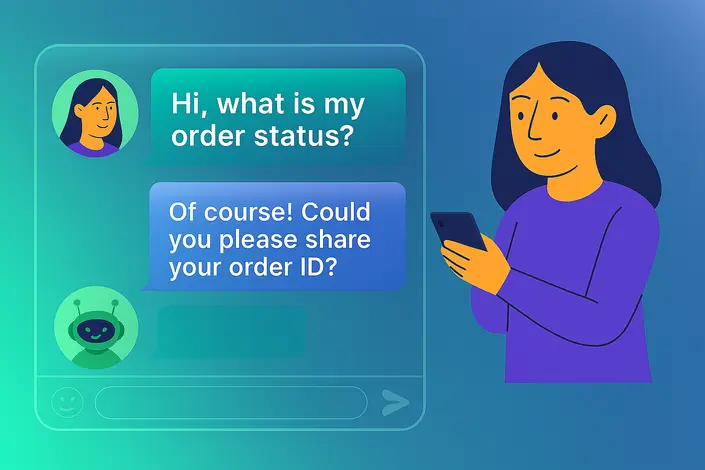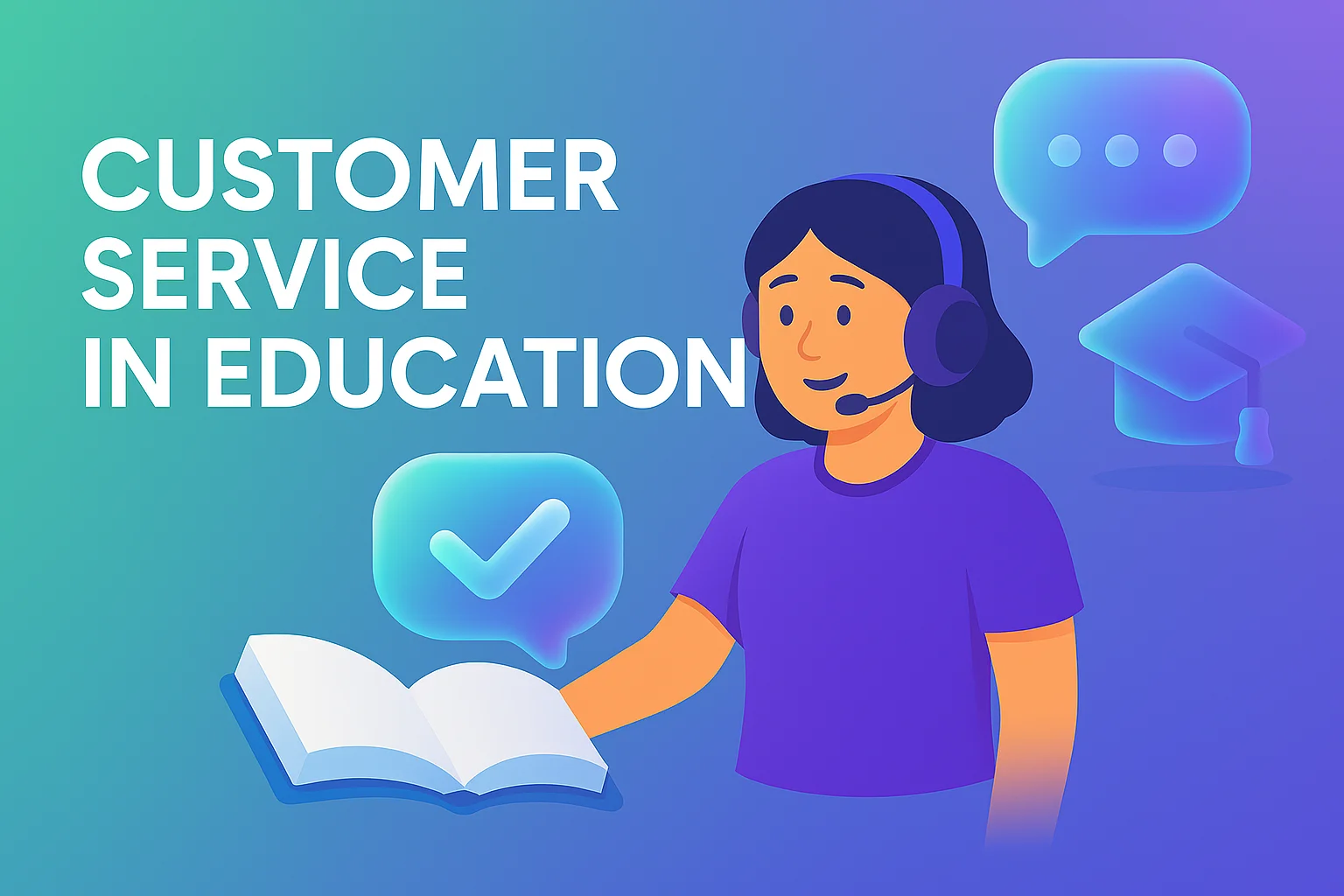Product Centric Vs Customer Centric – Which is Better?
- May 12, 2023
- 12 mins read
- Listen

There was a time when most companies focused heavily on selling a product-first experience. They believed that having the best product with great features was enough to win the trust and loyalty of customers. While everything was good with this approach, it ignored one key aspect – the customers.
A product-centric approach was fine until customers were not evolved but times have changed. Today, customers matter the most, and a business that works on meeting their needs and preferences stays ahead of its competitors.
This clearly explains where product-centric and customer-centric approaches differ and where they align. If a customer is not happy with the experience with your product or your brand, no matter how amazing products you have, it won’t matter much.
For that reason, a growing number of organizations have started to strike a balance between product and customer-centricity to keep customers satisfied and also increase revenue as well.
In this blog, we will explore the key differences between product and customer-driven organizations and also see some customer-centric and product-centric examples from the industry.
But first, let’s get started with understanding what exactly is a product-centric approach…
What is the Product-Centric Approach?
The product-centric approach is a business strategy where the main focus is on creating and delivering quality products to meet customer needs. In this approach, the primary emphasis is on the design and development of high-quality products so that the business can stand out in the market.
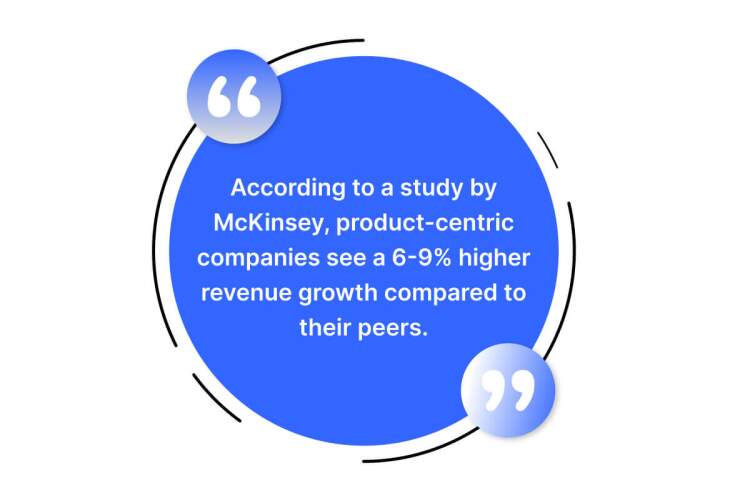
When a company is product-centric, all its goals and decisions revolve around the product itself. That is why they always analyze product quality, track performance, and customer response. Many businesses find it necessary to use various product analytics tools for deeper understanding to track every metric about their products. These insights help make plans to satisfy what customers want.
In this approach, the main focus is given to product features, quality, and innovation. Great attention is offered to creating products that are superior to competitors, and that can help attract and retain customers. In addition, in a product-driven approach, businesses prioritize promoting the features and benefits of the product.
What is the Customer-Centric Approach?
The customer-centric approach is a business strategy that emphasizes on understanding and meeting the needs of customers. In this approach, organizations give focus on building strong relationships with customers by ensuring amazing service and great experiences.
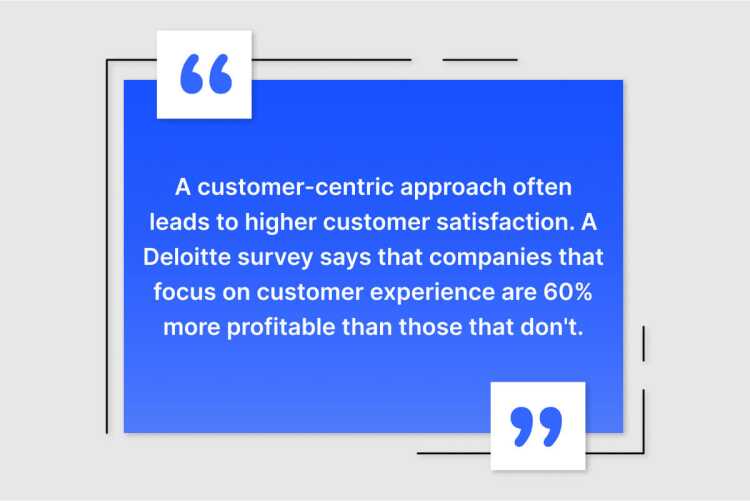
When a company follows a customer-centric approach, all its goals and decisions revolve around the customers and offering tailored solutions to their problems. In successfully following this approach, the role of customer service and support teams is big as it identifies pain points and ensures the relevant solutions.
When a company is driven by customer-centricity, it means it prioritizes customer satisfaction, loyalty, and retention. It means customer obsession is a top priority for it. The primary goal is to create a customer experience that helps in attracting and retaining customers, resulting in strong relationships.
Benefits of Being a Product-Centric Organization
Being product-centric is directly related to placing a strong focus on meeting the needs and desires of the customers. After all, 66% of customers expect brands to understand their needs. While the end goal is to achieve happier customers, the methods and routes could be varied, from improving products to services.
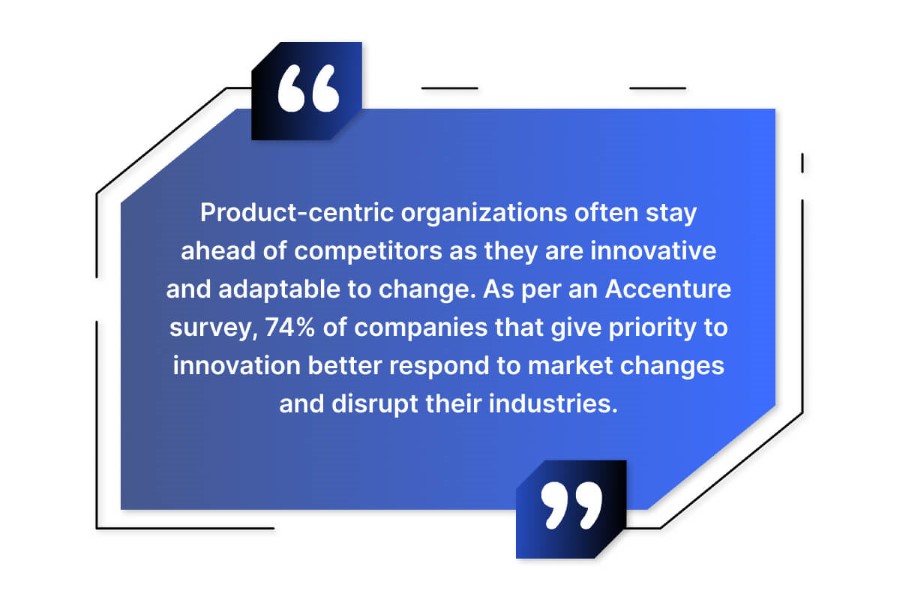
The benefits of adopting a product-centric approach are many, including –
- Higher customer satisfaction – A product-driven company will always give more priority to product development and improvement. This kind of approach will always result in products that better meet the need of its customers, resulting in higher customer satisfaction.
- Competitive advantage in the market – A product-centric company is more likely to create and deliver high-quality products. This can help it gain a competitive edge in the market and increase revenue growth and profit.
- Innovative solutions – When an organization focuses more on product development, it not only offers new products but also innovative solutions as well. This prepares it to better handle the changing market dynamics and stay ahead of the curve.
- A clear product roadmap – Product-focused companies tend to have a clearer understanding of the product roadmap which enables them to streamline the workflows and processes. All this ensures greater productivity and efficiency.
- Greater employee engagement – A strong focus on the product can help organizations align their workforce around a shared goal and offer them a sense of purpose. This can create superior employee engagement and retention.
Benefits of Being a Customer-Centric Organization
A customer-centric company puts the customers at the center of all the activities and decisions. This approach can ensure increased customer satisfaction and loyalty. Adopting this strategy can also get improved trust and revenue for the business. After all, such companies are 60% more profitable than others.
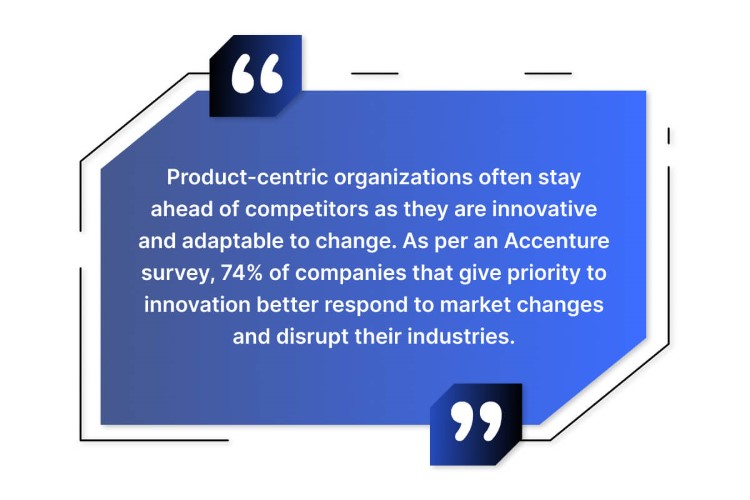
The benefits are many when an organization adopts a customer-centric strategy.
- Higher customer lifetime value – When a company focuses on customer needs, it creates positive experiences more often that result in increased loyalty. Loyal customers not only bring repeat business but also lead to higher customer lifetime value.
- Improved customer satisfaction – Understanding and meeting the needs of the customer is often the foundation of a customer-centric organization. This approach leads to higher levels of customer satisfaction.
- Increased revenue – Happy and satisfied customers not only stick with the business but also recommend it to others. Such recommendations can ensure higher revenue for the business.
- More customer acquisition – Offering a superior customer experience can give a competitive advantage to any business. Such companies not only stand out in the market but also attract more customers.
- Improved brand reputation – Focusing on the customer more can help improve the trust level among the target market. This can help gain an improved brand reputation in the market.
Product-Centric Vs Customer-Centric – What are the Similarities?
Creating value for customers is the common theme whether a company is a product or customer-centric. In both these strategies, organizations need to innovate to stay competitive and make customers happy if they want to make a profit.
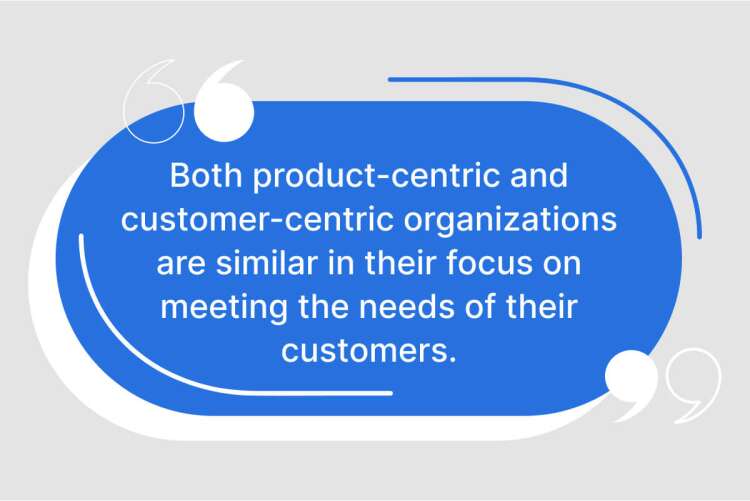
Here are some of the similarities that customer and product-centric approaches have –
Value Creation
Both approaches aim to create value for customers either directly or indirectly. A product-driven approach puts a direct focus on creating innovative products that can meet the needs and demands of the customers. On the other hand, a customer-focused company looks to create a positive experience that can meet the needs of customers.
Innovation
Whether a company is customer or product-centric, it requires innovation to stay ahead of the curve and meet the ever-growing expectations of customers. For a product-driven company, the real emphasis is on creating innovative products that meet the expectations of the audience. On the contrary, for a customer-focused company, the real goal is to create a customer-centric culture with innovation at the core of all business areas.
Need Analysis
A successful business is one that consistently meets and exceeds the needs of its customers. To achieve this goal, the first important thing is need analysis which can be done by market research. A product-centric company researches the market to identify gaps in what their products deliver and what customers expect. On the other hand, a customer-centric company uses research to understand the exact customer needs and then develops & delivers services to meet those needs.
Customer Satisfaction
Ensuring customer satisfaction is always the main of a business whether it follows a product or customer-centric strategy. While a customer-driven organization uses the power of personalized services to achieve customer satisfaction, a product-driven company offers high-quality products to achieve the same goal.
Revenue Generation
Generating a profit is the main focus of both approaches. Creating quality products is one way of generating revenue as then customers get attracted to the innovative features and do purchase. Offering excellent service is another way to make customers loyal and get repeat purchases.
Customer-Centric Vs Product-Centric – What are the Differences?
A company can be either product-driven or customer-focused, depending on what it prioritizes. Both approaches have many things similar such as ensuring quality products to customers and working for improved customer satisfaction. However, there are some key differences as well that separate one from the other.
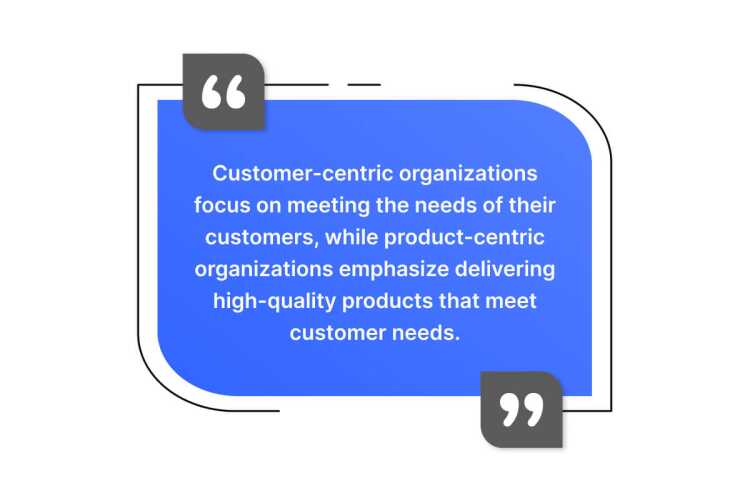
Some of the key differences between a customer and a product-centric approach are as follows –
Focus
When a business follows a product-centric approach, its main focus will be on the product and also on how to create and sell quality products to customers. On the contrary, when a company is customer-driven, its main goal is to first understand and then meet the needs of customers by offering them great services and support.
Strategy
The main strategy of a product-oriented company is to use its own perspective in developing, innovating, and improving its products. In contrast, the main strategy of a customer-centric company is to seek customer feedback and analyze their needs before improving the product and service experiences.
Innovation
For a product-focused company, the focus of innovation is always around the product itself with the main goal to create something that is better than the rest. On the other hand, the real purpose of innovation for a customer-driven company is to enhance the customer experience and take measures to meet their specific needs.
Marketing
A company that is focused on the product often markets the features and benefits of the products. It offers its product as the best in the market, In contrast, a company that is customer-driven often markets its products on its ability to improve customers’ experience and solve problems.
Examples of Brands Following Product-Centric Approaches
There are many companies that have historically focused on developing and improving their products rather than giving too much focus on meeting the needs of the customer. This approach has served them well in ensuring innovative and successful products.
Here are those examples –
- Apple – Apple’s single-minded focus on products has paved the way for the development of iconic tech gadgets such as the iPhone and iPad. For years, the company has stuck to the philosophy of creating innovative and era-defining products for customers.
- GoPro – This company focuses on developing high-quality cameras and accessories and it has built a strong brand around its product. It has created a loyal customer base that values innovation and quality with the cameras.
- Dyson – It specializes in developing high-end vacuum cleaners, quality air purifiers, and new-age hair styling tools. The company invests heavily in R&D and is known for innovation and quality.
Examples of Brands Following Customer-Centric Approaches
Many brands understand the significance of being customer-centric to gain an edge in the market and build a loyal customer base. They have not only achieved success with a customer-driven approach but have also ensured quality products and services as well.
Some examples of bands that focus on customers include –
- Amazon – When it comes to offering a seamless online shopping experience to customers, not many brands can match Amazon. To achieve success with the customer-centric strategy, the company has an experienced customer service department that is committed to resolving any customer issue instantly.
- Zappos – When a company offers free shipping and returns and has a dedicated customer service team in place, you know its focus lies in serving customers. Zappos is one such company – an online shoe and clothing retailer – that prioritizes customer service above everything else.
- Warby Parker – Not many eyewear companies can claim to match the kind of customer service and convenience that Warby Parker provides. The company gives its customers a home try-on program so that any purchase can happen after the trial.
Elevate Your Business’ Customer Centricity
Customers should be the foremost priority for any business. Giving them superior experiences has to be a top focus for your business. To achieve all this, you will need the right set of engagement tools and technology.
With REVE Chat, your company can find top-class customer support tools such as AI-powered chatbots to engage and interact with your customers.
In addition, we have video chat and co-browsing software as well that can help improve the level of support. Using all these tools can prove helpful in elevating the overall service experience for the customer.
In addition, we have live chat software that your business can add to the chatbot and start offering hybrid support to customers. In this type of support, a bot can handle routine automated queries while human agents can take over complex issues.
Final Thoughts
Both customers and products are two of the most important things a business needs to control. If the product is not good, no matter how much a business tries it can never make the customer happy. If the customer experience is not great, an amazing product can’t do much beyond a point.
At REVE Chat, we realize how companies need to keep a nice balance between both approaches of customer and product-centricity.
You can sign up with us and check our engagement tools to enhance customer experience with your brand.
Frequently Asked Questions
It depends on the specific industry and business goals. A product-centric approach works well for tech and innovation-driven businesses, while a customer-centric approach is important for service industries and brands that rely on loyalty and retention.
Yes! The best businesses balance both strategies, offering high-quality products/services while ensuring they also meet customer needs and preferences.
Brands can follow some of these strategies like: optimizing product offerings based on customer feedback, personalizing experiences, offering better customer service, and focusing on long-term customer relationships and loyalty rather than one-time sales.
Not at all. A customer-centric approach enhances product development by optimizing it based on customer needs and preferences, leading to better offerings and stronger brand loyalty.
Customer data helps businesses personalize experiences for each customer segment, predict their needs, and improve overall services, making customer-centric strategies more effective.

